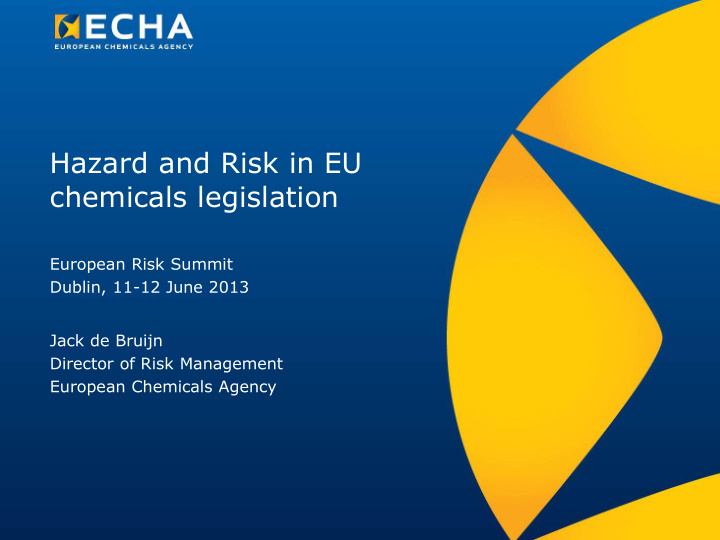



Hazard and Risk in EU chemicals legislation European Risk Summit Dublin, 11-12 June 2013 Jack de Bruijn Director of Risk Management European Chemicals Agency
Contents • Risk Assessment as a cornerstone of REACH • Dealing with Substances of Very High Concern • CMRs • PBTs/vPvBs • Conclusions
Shifting the burden of proof REACH is based on the principle that industry should • manufacture, import or use substances with such responsibility and care as may be required to ensure that, under reasonably foreseeable conditions, human health and the environment are not adversely affected Companies handling chemicals should take the • necessary risk management measures in accordance with the assessment of the risks of substances and pass on relevant risk management recommendations down the supply chain for all supported uses 3
Downstream obligations • Formulators and other downstream users need to comply with the recommended operational conditions and risk management measures they receive for their own use and use further down the supply chain • Otherwise they need to: • Request their suppliers to improve the risk assessment (CSA) and adapt the risk management recommendations • Or carry out their own CSA (and inform the Agency) 4
Annex I of REACH: Iterative CSA process Information: available required/needed Exposure Assessment Hazard Assessment • • Classification Build exposure scenarios • • PBT/vPvB assessment Estimate exposure levels • PNECs and DNELs Risk Characterisation Document in Registration Dossier, including CSR Risk y n controlled ? Communicate ES with extended SDS
Limits/uncertainties • Data availability • Estimating ‘safe‘ levels for humans or ecosystems • Estimating exposure further down the supply chain • Assessing exposure to the environment through different sources and routes • Estimating effectiveness of and adherence to recommended safety advice • Combined exposure to (similarly acting) substances 6
When to be more cautious? In risk assessment increased uncertainties are usually • taken care of by application of a higher uncertainty factors! But, experienced has learned that when the exposure is • more difficult to predict, hazards are more severe and long-term and control and the assessment of risks is done with higher uncertainties than normal and hence the consequences of not being protective are more disastrous…………… ………….a more cautious approach is warranted Under REACH Substances of Very High Concern (SVHCs) • are subject to careful attention 7
CMRs
Carcinogens or mutagens at work Directive 2004/37/EC • Reduction and replacement: • Employers must reduce the use of a carcinogen or mutagen, particularly by replacing it, as far as is technically possible, with a substance, preparation or process that is not dangerous or is less dangerous. • Prevention and reduction of exposure • Employers must ensure that the carcinogen or mutagen is manufactured and used in a closed system. If this is not technically possible, employers must ensure that the level of exposure is as low as is technically possible. 9
CMRs in REACH Supply as such or in mixtures to consumers normally • forbidden Selected CMRs made subject to authorisation process: • Ultimate implementation of the ‘Reversal of Burden of Proof’ • Industry needs to obtain an authorisation for continued use • CMRs Use can be authorised if the socio-economic benefits • outweigh the risks and no suitable alternatives are available Aim is to progressively substitute these substances by • alternative substances or technologies Legislative system provides pressure to continuously search • for long-term alternative solutions 10
PBTs/vPvBs
Why are we concerned about PBTs/vPvBs? • Specific concern due to their potential to accumulate in parts of the environment • Such accumulation is practically difficult to reverse as cessation of emission will not necessarily result in a (quick) reduction in chemical concentration • As a consequence those substances have a high potential to contaminate even remote areas • Effects and behaviour of PBT substances are difficult to predict in the longer term 12
Are our test data and criteria sufficient? • Degradation rates in pristine environments? • Accumulation in top-predators? • Long-term effects? 13
How to manage PBTs and vPvBs under REACH? Registration by Industry: • Specific identification as part of the CSA • Emission and exposure minimisation Authorities: • SVHC identification • Authorisation requirement; Use can be authorised if the socio-economic benefits outweigh the risks and no suitable alternatives are available 14
Conclusions • Decisions by industry and authorities under REACH are normally based on risk assessment • Whereas risk assessment is a well established process we need to recognise as well its limitations and uncertainties • Level of hazard integrated in the system, mainly to support policy decisions on priorities and ‘level of scrutiny’ by authorities 15
Thank you! jack.de-bruijn@echa.europa.eu
Recommend
More recommend